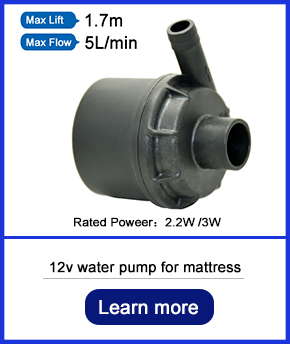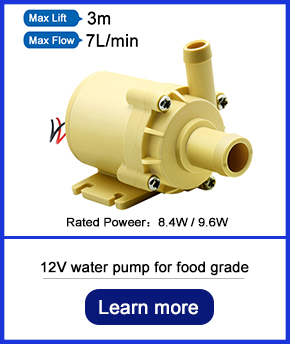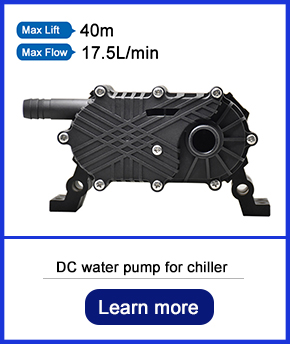Complete Guide to BLDC Water Pumps: Principles, Core Advantages, and Scenario-Based Applications
Published:2025-04-03
1. What is a BLDC Water Pump? Core Technical Analysis
A BLDC water pump (Brushless Direct Current Water Pump) is driven by a brushless DC motor, using electronic commutation to replace traditional carbon brushes for efficient, quiet, and long-life operation. Key technologies include:
a. Brushless motor design: Eliminates brush wear, achieving a lifespan of 20,000+ hours (vs. 2,000 hours for traditional brushed pumps)
b. Three-phase variable frequency control: Adjusts speed via PWM duty cycle, enabling 10%-100% flow regulation
c. Magnetic isolation technology: Fully isolated stator and rotor for IP68 waterproofing
Technical formula: Output power (W) = Voltage (V) × Current (A) × Efficiency (η), with typical efficiency ≥90%
 |  |  |
2. Core Advantages vs. Traditional Pumps (with Test Data)
Item | BLDC Water Pump | Traditional Brushed Pump | Performance Comparison |
Lifespan | 20,000+ hours | 1,500-2,500 hours | 10x longer |
Noise Level | ≤35dB (hydronic mattress) | 55-70dB | 50% quieter |
Energy Efficiency | 0.52 (24V/150W pump, 40m head) | 0.28 | 46% more efficient |
Maintenance | Maintenance-free | Quarterly brush replacement | 0 maintenance cost |
3. People Also Ask: In-Depth Answers
Q1: What high-pressure scenarios are BLDC pumps suitable for?
a. Energy storage thermal management: Tesla Megapack uses 36V BLDC pumps for 10bar high-pressure circulation.
b. Server liquid cooling: Huawei Atlas 900 uses 24V BLDC pumps for 200m head cavitation-free delivery.
c. Industrial chillers: Grundfos CRN series BLDC pumps adapt to 400V AC-DC systems, achieving 300L/min flow.
Technical implementation: Multi-stage impeller boosting and high-pressure sealing (e.g., perfluoroelastomer seals) Breaking through the pressure limitations of traditional DC pumps.
Q2: How to calculate BLDC pump energy consumption?
Two-factor formula:Energy (kWh) = (Power (W) × Runtime (h)) ÷ Efficiency (η)
a. Example: 36V/200W pump (93% efficiency) running for 10 hoursActual energy = (200 × 10) ÷ 0.93 ≈ 2.15 kWh.
b. Energy-saving tip: Enable smart sleep mode (e.g., low-load standby for energy storage), reducing consumption by 50%.
Q3: How to select the waterproof rating for BLDC pumps?
Scenario-based standards:
Application | Recommended Rating | Technical Requirements | Case Example |
Food-grade transport | IP67 | Stainless steel + NSF 61 certification | Brand X food-grade pump (12V DC) |
Hydronic mattress | IP65 | Flexible tubing + silent bearings | Midea hydronic pump (24V DC) |
Energy storage cooling | IP68 | Anti-vibration + low-temperature (-40℃) | CATL energy storage pump (36V) |
Q4: What's the difference between BLDC and permanent magnet motors?
Key differences:
a. BLDC motor: Electronic commutation with sensorless control (e.g., vector algorithm for energy storage pumps).
b. Permanent magnet motor: Rotor embedded with NdFeB magnets, efficiency up to 95% (QianTao high-speed motor technology).
c. Application choice: Prioritize permanent magnet BLDC for high speed (>15,000 RPM), standard BLDC for general use.
4. Scenario-Based Applications (with Technical Cases)
a. Food-Grade Liquid Transportation (12V BLDC)
(1) System composition: 316 stainless steel pump + food-grade seals + smart flow sensor
(2)Technical highlights:
(a) Compliant with FDA 21 CFR 177.2600 for beverage/dairy transport
(b) Self-priming height ≤4m to prevent residue contamination (Brand SP-100 pump test data)
b. Hydronic Mattress Circulation (24V BLDC)
(1) Design specs:
(a) 15m head, 50L/min flow, noise ≤30dB
(b) Smart temperature linkage: Auto-decelerate when water temp >55℃, saving 35% energy
(2) User value: Maintenance-free design, lifespan ≥10 years (Midea MC-800 series test)
c. Energy Storage Thermal Management (36V BLDC)
(1) System composition: ATCP pump + redundant cooling loop + temperature sensor array
(2) Test data:
(a) Supports -30℃~60℃ operation, battery temperature difference ≤±1℃
(b) Extends energy storage lifespan by 20% vs. traditional pumps (Tesla Megapack case)
5. Selection Guide & Technical Standards
a. Three key selection factors
(1) Voltage adaptation: Choose wide-voltage models (±15% of system voltage, e.g., 18-30V for 24V systems)
(2)Scenario parameters:
(a) Determine traffic demand
(b) Calculate the required head
(c) Select voltage level
(d) Verify materials and certification
(3) Case reference:12V stainless steel pump for food factories, 36V/IP68 pump for energy storage, 24V silent pump for hydronic mattresses
b. Material & certification standards
(1) Food-grade scenarios: Pump materials must pass NSF 61 and FDA certifications (e.g., 316 stainless steel + EPDM seals)
(2) Energy storage scenarios: Low-temperature resistant materials (-40℃~85℃) + UL 1741 certification (solar pump standard)
6. Industry Trends & Cutting-Edge Technologies
a. 2025 technical directions
(1) Smart integration: Built-in AI chip for real-time flow optimization (e.g., thermal resistance compensation algorithm for energy storage pumps)
(2) Material innovation: Carbon fiber-reinforced polymer pump body, 40% lighter with 3x strength increase
(3) Solar integration: Solar-powered BLDC pumps (e.g., SunPower off-grid irrigation solution)
b. Cost-benefit analysis
Type | Initial Cost (USD) | 5-Year Life Cycle Cost (USD) | Maintenance Frequency |
Traditional brushed | 80-150 | 1,200-1,500 | Quarterly |
Standard BLDC | 200-300 | 300-400 | 0 maintenance |
Permanent magnet BLDC | 300-400 | 200-250 | 0 maintenance |
- Distribution in Water Heater Mattresses: Why BLDC Pumps Ensure Uniform Heating
- How BLDC Pumps Ensure Precise Flow in Water Dispensers
- Why BLDC Pumps Are Essential for Smart Toilets
- The Critical Role of Automotive Electronic Water Pumps in New Energy Vehicle Battery Thermal Management
- Noise Control Technology for Smart Toilet Water Pumps: Enhancing Quiet Operation in Modern Bathrooms
- Unveiling the Working Principle of Automotive Electronic Water Valves
- Comparative Analysis of Liquid-Cooled Pumps vs. Air-Cooled Systems for EV Charging Stations
- Technical Application of Brushless DC Motors in Energy Storage Circulation Pumps
- Water Heater Pump: Efficiency Upgrade for Low-Voltage Systems
- How Dishwasher Water Pumps Enhance Cleaning Coverage Through Stable Operation?
